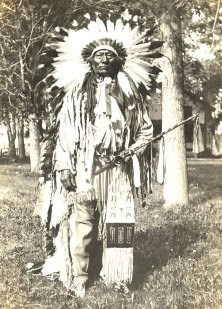
A noted Minneconjou Lakota warrior; he was later a chief in reservation life. As a boy he was known as Bull-Standing-with-Cow. Born in 1849 on the north edge of the Black Hills, his father and grandfather before him were chiefs of the Minneconjou Lakota, and his mother, Good Feather, was Sitting Bull's sister. The famous Hunkpapa Lakota leader was his uncle. With such parentage he could not help but become an outstanding warrior. Bull-Standing-with-Cow began his life as a warrior in 1865 at the age of 16, about the time when warfare with the whites erupted into almost continuous conflict. This warfare began during the Connor Expedition of 1865 and built to a climax with the Battle of the Little Bighorn, June 25-26, 1876. Bull-Standing-with-Cow first made his mark as a warrior in 1865 when he counted coup on three enemy Indian scouts, knocking all three from their mounts. In addition, he took 10 horses from the enemy. As a result of his heroic deeds, his uncle, Black Moon, christened him White Bull. Before the attack on soldiers at Fort Phil Kearny in December 1866, White Bull was invited to join the prestigious Fox Soldier warrior society. White Bull was among the Minneconjou, Oglala, and Cheyenne who sprang the trap on Captain William Fetterman's command of 80 men. In the battle, White Bull pulled a wounded warrior from the fight and killed one soldier with his bow and arrow. He arrived at the finish just as the last cavalry trooper was killed in hand-to-hand fighting. White Bull was primarily an observer at the Wagon Box fight, August 1, 1867, where approximately 30 wood cutters and their soldier escort led by Captain James Powell held off as many as 1,000 warriors with their newly acquired breech-loading rifles. The warriors initially charged the wagon corral on horseback but later dismounted and attacked by foot. The Indians claimed only six killed in the fighting and a like number wounded. The whites lost six men killed in defense. In subsequent years, White Bull distinguished himself in a number of skirmishes and horse stealing raids against the Crows, Assiniboine and Flatheads. In August 1872, White Bull joined Sitting Bull in a daring pipe smoking exhibition of bravery. This was done in full view of soldiers along the Yellowstone who were guarding a railroad surveying crew. The soldiers repeatedly fired at the sitting pipe smokers, kicking up dust all around them to no effect. Sitting Bull calmly smoked the pipe, passed it to others in the circle, and then casually cleaned the pipe, before walking back out of range of the soldier rifles. This act of bravery greatly impressed the Lakota and Cheyenne. White Bull later called it, "the bravest deed possible." White Bull reached the pinnacle of warrior achievement against the whites during the summer of 1876. At the Battle of the Rosebud, June 17, 1876, White Bull charged headlong on horseback against a Shoshone scout of General George Crook. Both fired their repeating rifles into the other; the Shoshone missed, but White Bull knocked the Shoshone's horse down with two bullets to the Shoshone mount's right fore-shoulder. White Bull then rode the Shoshone down and 'lamed him' in the right leg, before riding off. At the Battle of the Little Bighorn, June 25-26, 1876, White Bull played a very active role in the battle. In the fight White Bull counted seven coups, six of them 'firsts,' killed two men in hand-to-hand combat, captured two guns and twelve horses, had his horse shot from under him, and was wounded in the ankle by a spent bullet. Sitting Bull's Lakota continued to resist Colonel Nelson Miles' troop build-up along the Yellowstone River in the fall of 1876. When Sitting Bull crossed over into Canada that winter, White Bull chose to stay with his people, the Minneconjou. They settled at the Cheyenne River Agency along the Missouri River in present day South Dakota. Many years later, in 1932, White Bull narrated his story as a warrior in his youth to historian Stanley Vestal. It remains one of the most complete accounts of a northern Plains Indian warrior's life. Joseph White Bull died July 21, 1947, he was 98 years old.
|
Last updated: April 23, 2025
